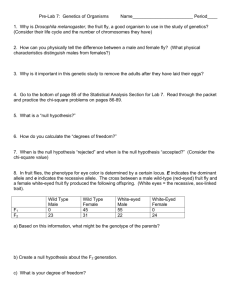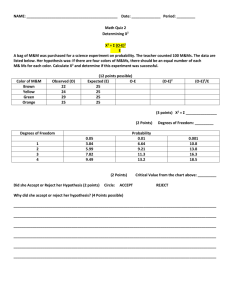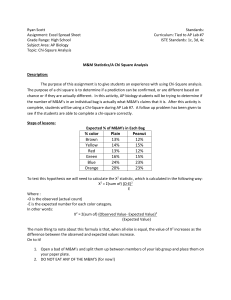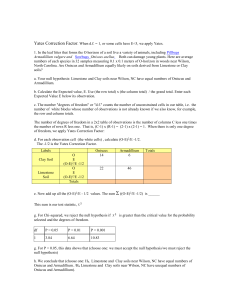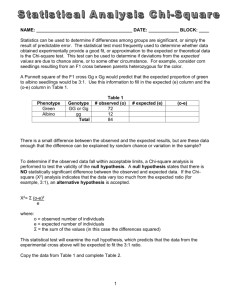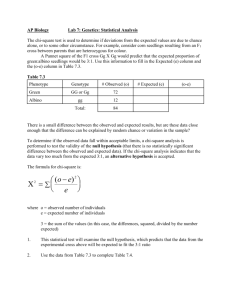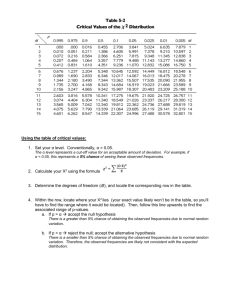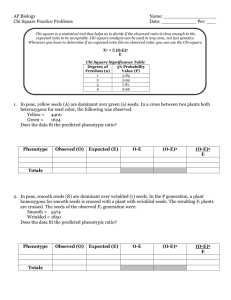Chi Square Practice Problems and Prelab Online Fly
advertisement
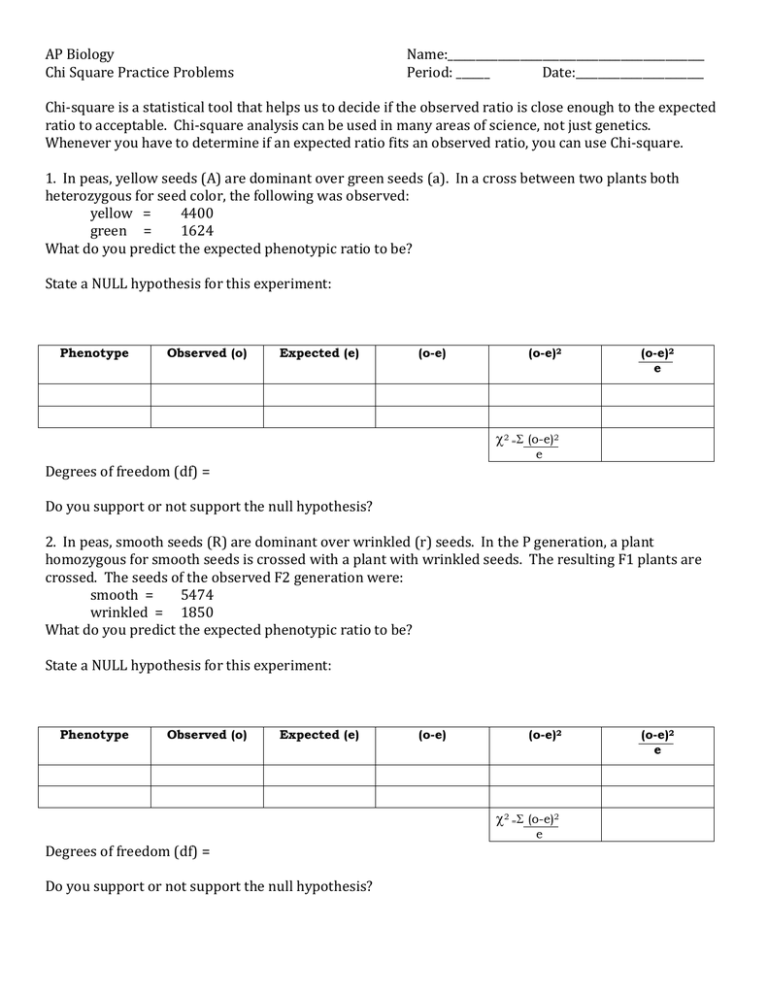
AP Biology Chi Square Practice Problems Name:______________________________________________ Period: ______ Date:_______________________ Chi-square is a statistical tool that helps us to decide if the observed ratio is close enough to the expected ratio to acceptable. Chi-square analysis can be used in many areas of science, not just genetics. Whenever you have to determine if an expected ratio fits an observed ratio, you can use Chi-square. 1. In peas, yellow seeds (A) are dominant over green seeds (a). In a cross between two plants both heterozygous for seed color, the following was observed: yellow = 4400 green = 1624 What do you predict the expected phenotypic ratio to be? State a NULL hypothesis for this experiment: Phenotype Observed (o) Expected (e) (o-e) (o-e)2 (o-e)2 e 2 = (o-e)2 e Degrees of freedom (df) = Do you support or not support the null hypothesis? 2. In peas, smooth seeds (R) are dominant over wrinkled (r) seeds. In the P generation, a plant homozygous for smooth seeds is crossed with a plant with wrinkled seeds. The resulting F1 plants are crossed. The seeds of the observed F2 generation were: smooth = 5474 wrinkled = 1850 What do you predict the expected phenotypic ratio to be? State a NULL hypothesis for this experiment: Phenotype Observed (o) Expected (e) (o-e) (o-e)2 2 = (o-e)2 e Degrees of freedom (df) = Do you support or not support the null hypothesis? (o-e)2 e 3. In a flowering plant, white flowers (B) are dominant over red (b), and short plants (E) are dominant over tall (e) plants. When two double heterozygote (BbEe) plants were crossed, the resulting phenotypes were observed: white, short = 206 red, short = 83 white, tall = 65 red, tall = 30 What do you predict the expected phenotypic ratio to be? State a NULL hypothesis for this experiment: Phenotype Observed (o) Expected (e) (o-e) (o-e)2 (o-e)2 e 2 = (o-e)2 e Degrees of freedom (df) = Do you support or not support the null hypothesis? 4. In corn, purple kernels (D) are dominant over yellow (d), and smooth kernels (G) are dominant over shrunken (g). The offspring below are the result of a true dihybrid cross. The F1 ear of corn has 381 kernels with the following types: purple/smooth = 216 purple/shrunken = 79 yellow/smooth = 65 yellow/shrunken = 21 What do you predict the expected phenotypic ratio to be? State a NULL hypothesis for this experiment: Phenotype Observed (o) Expected (e) (o-e) (o-e)2 2 = (o-e)2 e Degrees of freedom (df) = Do you support or not support the null hypothesis? (o-e)2 e 5. Color blindness is a sex-linked trait in Wombats. A female who is a carrier of the color blind allele mates with a male who is color blind. The phenotypes of their offspring are: Normal female = 132 Color blind female = 124 Normal male = 126 Color blind male = 136 What do you predict the expected phenotypic ratio to be? State a NULL hypothesis for this experiment: Phenotype Observed (o) Expected (e) (o-e) (o-e)2 (o-e)2 e 2 = (o-e)2 e Degrees of freedom (df) = Do you support or not support the null hypothesis? 6. In cats, fur color is determined by the codominant, sex-linked alleles: black (B) and orange (O). A calico female is bred many times with a black male. They produce the following offspring: black female = 78 calico female = 65 black male = 81 orange male = 45 What do you predict the expected phenotypic ratio to be? State a NULL hypothesis for this experiment: Phenotype Observed (o) Expected (e) (o-e) (o-e)2 2 = (o-e)2 e Degrees of freedom (df) = Do you support or not support the null hypothesis? (o-e)2 e An investigator observes that when pure-breeding, long-winged fruit flies are mated with pure-breeding, short-winged flies, the F1 offspring have an intermediate wing length. When several intermediate-winged flies are allowed to interbreed, the following results are obtained: 230 long-winged flies, 510 intermediate winged flies, 260 short winged flies. What do you predict the expected phenotypic ratio to be? State a NULL hypothesis for this experiment: Table 7.4 Phenotype Observed (o) Expected (e) (o-e) (o-e)2 (o-e)2 e 2 = (o-e)2 e How many degrees of freedom (df) are there? _____ What is the p value for these data? _____ Can you accept or reject the null hypothesis? Explain why. Now, go to website for online fly-lab: http://www.sciencecourseware.com/vcise/drosophila/ 1. Sign in as a guest. 2. Learn how to work the program REALLY WELL by doing the following crosses below. You need to be able to do this with options turned off in class, so you can quickly go through 3 crosses. 3. Go through each of the practice crosses below, pay attention to the type of cross and think about the expected ratio that should occur. The hard part is determining if it is an autosomal or sex-linked trait. Hypothesize on the expected ratio by looking at F1 offspring numbers. Practice crossing F2’s from F1’s. See if predicted ratios occur to confirm your hypothesis. Practice entering the chi-square data. You need to keep the expected numbers for chi-square in WHOLE numbers. You will have to determine what type of genetic interaction it is based on the observed results. Practice crosses: Mate a wild female to an eyeless eyed male. Mate a wild female to a spineless, bristles male. Mate a black body, brown eyed female to a wild male. Mate a scalloped winged female to a wild male. Lethal cross: you can cross a star eyed female to a wild male.

